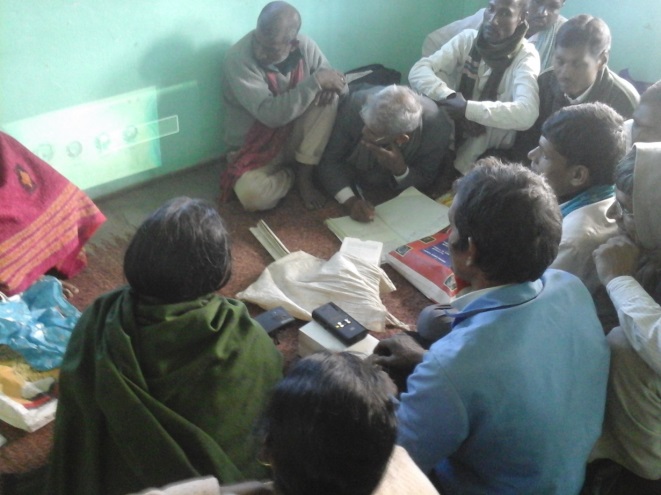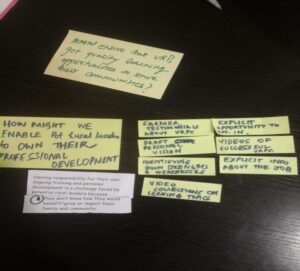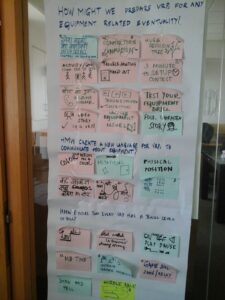To learn more about Digital Green’s AI-powered platform and how it impacts small-scale farmers in India, Ethiopia, Kenya, Nigeria and Nepal, we encourage you to sign up for our newsletter.
Inspiration and Ideation for Designers and Researchers

At the beginning itself, I have to admit that when I took a first glance at the human-centered design (HCD) approach, I couldn’t discern much difference between qualitative/participatory research methods and HCD research methods. I had mentioned in my earlier blog that at Digital Green, we decided to use the HCD approach to develop a more efficient training system. As we moved through the inspiration and ideation phase, I could see a lot of parallels between qualitative/participatory research and HCD, both in the approach and in the tools. However, there were some very specific differences too. What similarities did I find, and what were those differences?
Framing your Design challenge (or a Research Question)
at sorted, we set out to set ourselves a design challenge. Since creating a more effective and efficient training system was our main goal, we started developing our design challenge around it. The three main difficulties that we faced in framing our challenge were:
- How to frame a question that has appropriate scope? What is ‘nothing too wide and nothing too narrow’?
- How to ensure that our biases do not creep in into the question we frame?
- How do we know we have arrived at the right question?
 These issues are very similar to those a qualitative researcher faces when developing her/his research question. One benefit of designing a challenge within an organization is that at the beginning itself you might have a very good sense of the impact that you want to have. Whereas an academic researcher is not looking at impact per se, but at the knowledge and learning that the research can help create. And, therefore, this process could be much more ambiguous for her. At the same time, working in an organizational context can limit you right at the beginning. I personally felt so caught in thoughts like, ‘But this is not how things happen at DG’, ‘But others will never be open to this’, ‘Oh, it is going to be so difficult to implement something like this.’ Before we could free ourselves to be ‘creative’ and ‘innovative’, we were binding ourselves. What helped us to get through the process was:
These issues are very similar to those a qualitative researcher faces when developing her/his research question. One benefit of designing a challenge within an organization is that at the beginning itself you might have a very good sense of the impact that you want to have. Whereas an academic researcher is not looking at impact per se, but at the knowledge and learning that the research can help create. And, therefore, this process could be much more ambiguous for her. At the same time, working in an organizational context can limit you right at the beginning. I personally felt so caught in thoughts like, ‘But this is not how things happen at DG’, ‘But others will never be open to this’, ‘Oh, it is going to be so difficult to implement something like this.’ Before we could free ourselves to be ‘creative’ and ‘innovative’, we were binding ourselves. What helped us to get through the process was:
- Not trying to resolve all problems through one question
- Coming up with lots and lots of questions, narrowing them down, deciding unanimously the one which we definitely wanted to pursue to impact our community, and then refining it.
- While refining the question, keeping the impact that we wanted to create at the center, and not letting other organizational considerations affect us at this stage.
- For the following round of refinement, keeping an eye out for the real issues at the organization and field level and tweaking the question accordingly.
When deciding our challenge, we went from very broad and ambiguous questions, for instance, ‘how can we have an efficient training system?’, to very narrow and biased ones, for instance, ‘ how can video be used to train field level workers?’. After a lot of iterations, the design challenge that we came up with, that worked for us, was ‘How might we ensure that field level workers can operate equipment confidently?’
Choosing the right methods – for generating data + creating innovative solutions
To find solutions, we started off with planning our research. It can be a tough call deciding which methods would be the most appropriate for you to find the answers and get closer to your solutions. The method that you use can determine the information and answers you get. There can be endless methods to use in HCD – you can stick to fairly traditional ones, such as interviews, to more creative ones, such as making collages, or you can even develop your own!
I felt that reaching the right methods is a comparatively well-laid down path in academic research. Once you know your research approach and the epistemology, it is easier to find suitable methods to generate data that can answer your research question. In HCD, while you know the end you want to reach, the multitude of methods and their appropriateness can be slightly tricky to navigate through. Because you do not want to simply generate data, but you want to be ‘creative’ to find an ‘innovative’ solution. There are multiple purposes that methods in HCD research must fulfill. I found that in HCD mapping the methods against three main purposes can be rather helpful. These purposes are:
- Developing some basic knowledge about the challenge
- Thinking more creatively about the actual challenges and solutions
- Learning in-depth about the challenge from the people directly facing it
We used interviews and observation extensively for our first purpose – ‘developing some basic knowledge’. Analogous inspiration helped us get some creative ideas and peer-to-peer activities helped us delve deeper into the issues that field level workers faced. For example, one of the methods that we used was to ask one field level worker to explain the functioning of the pico projector to others. The image here represents one such activity. This ‘mix-methods’ approach helped us open our minds to the various possibilities of what solutions can look like.
Prototyping solutions, iteration and messiness
We did a thematic data analysis right after our secondary research and interviews to get further direction, and developed‘sub-challenges’ or ‘insight statements’. We zeroed in on three main things that can be possible solutions for an effective training system: 1) contextual training videos; 2) game-based objective assessment; 3) illustrative handout.

So far so good. So far very much like academic research. But this is where things changed… and got messy. Collecting data, analyzing it, developing prototypes, testing prototypes, collecting more data, analyzing the new data, developing another prototype…. All of it went on in a very intuitive and non-linear manner. One day you conduct a peer-to-peer activity and the very next day you’ve done a quick analysis developed a prototype and are out in the field testing it. It was nothing like… a literature review of data collection to data analysis to writing… what I did in a step-by-step manner while doing academic research. And the messiness didn’t make someone like me, who does things very systematically, happy and comfortable!
The messiness of the process also created some friction in the team, because often things didn’t make a lot of sense and I, for one, questioned if it was leading anywhere. But the deeper we dug, answers started becoming clearer. The more iteration we did on prototypes, the closer we got to our solution. After all, like they say, there was some method to the madness. What I learnt was this:
- Do not rely too much on assumptions based on your thematic analysis. Rely more on what the real life scenarios teach you.
- Prototyping can feel difficult, but just make something! Even a really quick and bare prototype will give you insights
- Every iteration should bring something new and answer your design challenge. When that stops happening, stop prototyping.
The hidden academic researcher in me initially desisted the quick iterative and non-linear nature of HCD, but also realized that the value in it is you do not spend too much time creating a ‘beautiful’ solution, which doesn’t work all that well. Quick iterations help you get rid of bad ideas before you’ve put in too much effort, money and time, and (more dangerously) before you get quite convinced about your ideas yourself!
More than the ‘method’, the madness was what I started enjoying in our subsequent use of HCD. This included creating our own ‘methods’ and process variations. Since I have done participatory video, I used some techniques from it for developing prototypes. In my next blog, I would focus on using participatory video technique in HCD, what it meant for us to co-create and where it took us while creating our solutions.